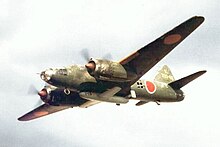Mitsubishi G4M
| Mitsubishi G4M | |
|---|---|
 Mitsubishi G4M-45 |
|
| Type: | bomber |
| Design country: | |
| Manufacturer: | |
| First flight: |
October 23, 1939 |
| Number of pieces: |
2479 |


The Mitsubishi G4M Hamaki (cigar) was the most famous Japanese all-metal bomber in the Pacific during World War II . He flew the most missions during the Pacific War and got by the Allies the code name Betty . The G4M was also used as a torpedo bomber .
history
The aircraft , built by Mitsubishi Jūkōgyō , was commissioned by the Japanese Navy for the Japanese Navy Air Force . According to Mitsubishi's plans, the machine was supposed to be equipped with four engines , but the Navy opted for a twin-engine version. The special feature of this bomber was its long range, which was made possible by tanks integrated into the wings.
After its maiden flight on October 23, 1939, the G4M had its first extremely successful war mission in southeast China in May 1941 during the Chinese Civil War .
The Mitsubishi G3Ms and their further developed successor G4Ms had their greatest success when they attacked the British battleship HMS Prince of Wales and the battle cruiser HMS Repulse with armor-piercing bombs and torpedoes in the waters of Malaysia on December 10, 1941, two days after the attack on Pearl Harbor sunk. The Prince of Wales and the Repulse were the first capital ships to be sunk solely by an air strike in the open sea.
More than 250 machines were involved in the invasions in the Philippines and Malaysia . After the Battle of Guadalcanal in August 1942, it turned out that the large, relatively slow and unarmored machines occasionally caught fire and crashed after being hit. This earned the G4M the additional nickname One-Shot Lighter .
As the war situation deteriorated, day attacks became practically impossible due to the high losses, so that only night operations were carried out. Furthermore, a special version of the bomber was used towards the end of the war as a carrier aircraft for the manned Ōka Kamikaze gliding bombs ( Yokosuka MXY-7 ).
The Mitsubishi G4M was built in four main versions, the G4M1 Model 11, G4M2 Model 22, G4M3 Model 34 and the G6M1. There were also a few minor versions such as the G6M1-L2, which was designed as a transport aircraft. A total of 2479 machines were built, of which only about 160 were left at the end of the war.
On August 19, 1945, the Japanese surrender delegation was transported in two G4M1 machines to Ie-jima on the Ryūkyū Islands . The planes were painted white with green crosses as a sign of surrender.
Technical specifications
| Parameters | Data |
|---|---|
| length | 20.00 m |
| span | 25.00 m |
| height | 6.00 m |
| drive | two Mitsubishi MK4A Kasei 14-cylinder radial engines with 1530 hp (1825 hp for G4M2d model 27, G4M2c model 26 and G4M3 model 36) |
| Top speed | 455 km / h at an altitude of 4500 m |
| Max. Range | 5040 km |
| crew | 7 (10 in the G6M1) |
| Service ceiling | 9000 m |
| Armament | two 20 mm cannons, four 7.7 mm machine guns and up to 2200 kg bombs (including one 800 kg torpedo) |
| Total mass |
|
See also
literature
- Martin Ferkl, Mitsubishi G4M Betty , Revi, 2002, ISBN 80-85957-09-4
- Osamu Tagaya, Mitsubishi Type I Rikko Betty Units of World War 2 , Osprey Publishing, 2002, ISBN 1-84176-082-X
- Joseph M. Horodyski, British Gamble In Asian Waters , Military Heritage Volume 3, December 2001, pages 68-77 ( sinking of the British battleship Prince of Wales and battle cruiser Repulse by the Japanese on December 10, 1941 after the USA entered World War II )

